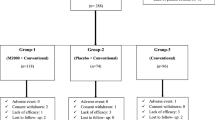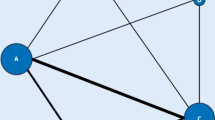Abstract
We investigated the efficacy and safety of bucillamine administered as a second-line DMARD compared to administration as a first-line DMARD in the treatment of rheumatoid arthritis (RA). We conducted a retrospective cohort study and reviewed medical records of 86 patients with active RA who began to receive bucillamine at Yokohama Minami Kyosai Hospital between January 1998 and July 2004. The efficacy of treatments was compared based on rates of achievement of 20, 50, and 70% improvement in ACR core set 6 months after initiation of the therapy. In the group administered bucillamine as a first-line DMARD (18 patients), 44.4, 22.2, and 11.1% of patients achieved ACR 20, 50, 70, respectively, while 56.5, 34.1, and 19.5% achieved ACR 20, 50, 70, respectively, in the group administered bucillamine following switching from MTX (46 patients), and 53.3, 33.3, and 13.3% achieved ACR 20, 50, and 70, respectively, in the group administered bucillamine following switching from Sulfasalazine (SSZ) (15 patients). The rates of achievements of ACR 20, 50, 70 did not differ statistically between the three groups and there was no increase in risk of serious adverse effects related to previous DMARDs. The usefulness of bucillamine as a second-line DMARD was demonstrated.



Similar content being viewed by others
References
Abe C. Clinical evaluation of immunomodulators. Int J Immunother. 1985;1:7–10.
Kashiwazaki S, Shiokawa Y. Bucillamine: a new immunomodulator. Int J Immunother. 1987;3:1–6.
Nagashima M, Shu G, Yamamoto K, Yamahatsu S, Yoshino S. The ability of disease modifying antirheumatic drugs to induce and maintain improvement in patients with rheumatoid arthritis. Epidemiology of DMARDs treatment in Japan. Clin Exp Rheumatol. 2005;23(1):27–35.
Iwatani M, Inoue E, Nakamura T, Nakajima A, Hara M, Tomatsu T, et al. Efficacy profile of bucillamine in rheumatoid arthritis patients in a large observational cohort study, IORRA. Mod Rheumatol. 2006;16(6):376–80.
Mimori T. Anti-rheumatic drugs. In: Ochi T, Yamamoto K, Ryuu J, editors. Manual of diagnosis and guideline for treatment of RA. Tokyo: Japanese rheumatism foundation; 2004. pp. 84–98. (in Japanese).
Ichikawa Y, Saito T, Yamanaka H, Akizuki M, Kondo H, Kobayashi S, et al. Therapeutic effects of the combination of methotrexate and bucillamine in early rheumatoid arthritis: a multicenter, double-blind, randomized controlled study. Mod Rheumatol. 2005;15:323–8.
Hirohata S, Lipsky PE. Regulation of B cell function by bucillamine, a novel disease-modifying antirheumatic drug. Clin Immunol Immunopathol. 1993;66(1):43–51.
Tsuji F, Seki I, Aono H, Odani N, Mizutani K, Okamoto M, et al. Bucillamine mechanism inhibiting IL–1beta-induced VEGF production from fibroblast-like synoviocytes. Int Immunopharmacol. 2007;7(12):1569–76.
Suematsu A, Tajiri Y, Nakashima T, Taka J, Ochi S, Oda H, et al. Scientific basis for the efficacy of combined use of antirheumatic drugs against bone destruction in rheumatoid arthritis. Mod Rheumatol. 2007;17(1):17–23.
Morabito L, Montesinos MC, Schreibman DM, Balter L, Thompson LF, Resta R, et al. Methotrexate and sulfasalazine promote adenosine release by a mechanism that requires ecto-5′-nucleotidase-mediated conversion of adenine nucleotides. J Clin Invest. 1998;101:295–300.
Gadangi P, Longaker M, Naime D, Levin RI, Recht PA, Montesinos MC, et al. The anti-inflammatory mechanism of sulfasalazine is related to adenosine release at inflamed sites. J Immunol. 1996;156:1937–41.
Haagsma CJ, Russel FG, Vree TB, Van Riel PL, Van de Putte LB. Combination of methotrexate and sulphasalazine in patients with rheumatoid arthritis: pharmacokinetic analysis and relationship to clinical response. Br J Clin Pharmacol. 1996;42(2):195–200.
Dougados M, Combe B, Cantagrel A, Goupille P, Olive P, Schattenkirchner M, et al. Combination therapy in early rheumatoid arthritis: a randomized, controlled, double-blind 52-week clinical trial of sulphasalazine and methotrexate compared with the single components. Ann Rheum Dis. 1999;58(4):220–5.
Arnett FC, Edworthy SM, Bloch DA, et al. The American Rheumatism Association 1987 revised criteria for the classification of rheumatoid arthritis. Arthritis Rheum. 1988;31:315–24.
van Riel PLCM, van Gestel AM. Clinical outcome measures in rheumatoid arthritis. Ann Rheum Dis. 2000;59(suppl 1):i28–31.
Yokota N, Kuga Y, Kanazawa T, Morishita M, Tanida K, Itou K. Ten years results of bucillamine in the treatment of rheumatoid arthritis. Mod Rheumatol. 2007;17(1):33–6.
Goekoop-Ruiterman YP, de Vries-Bouwstra JK, Allaart CF, van Zeben D, Kerstens PJ, Hazes JM, et al. Clinical and radiographic outcomes of four different treatment strategies in patients with early rheumatoid arthritis (the BeSt study): a randomized, controlled trial. Arthritis Rheum. 2005;52(11):3381–90.
Salliot C, Gossec L, Ruyssen-Witrand A, Luc M, Duclos M, Guignard S, et al. Infections during tumour necrosis factor-alpha blocker therapy for rheumatic diseases in daily practice: a systematic retrospective study of 709 patients. Rheumatology (Oxford). 2007;46(2):327–34.
Curtis JR, Patkar N, Xie A, Martin C, Allison JJ, Saag M, et al. Risk of serious bacterial infections among rheumatoid arthritis patients exposed to tumor necrosis factor alpha antagonists. Arthritis Rheum. 2007;56(4):1125–33.
Sekiguchi N, Kameda H, Amano K, Takeuchi T. Efficacy and safety of bucillamine, a D-penicillamine analogue, in patients with active rheumatoid arthritis. Mod Rheumatol. 2006;16(2):85–91.
Acknowledgments
The authors have no financial interest in this research that could create a potential conflict of interest or the appearance of a conflict of interest with regard to the work.
Author information
Authors and Affiliations
Corresponding author
About this article
Cite this article
Suda, A., Nagaoka, S., Ohono, S. et al. The efficacy and safety of bucillamine as a second-line DMARD in the treatment of rheumatoid arthritis: a retrospective cohort study. Mod Rheumatol 18, 609–614 (2008). https://doi.org/10.1007/s10165-008-0103-7
Received:
Accepted:
Published:
Issue Date:
DOI: https://doi.org/10.1007/s10165-008-0103-7




